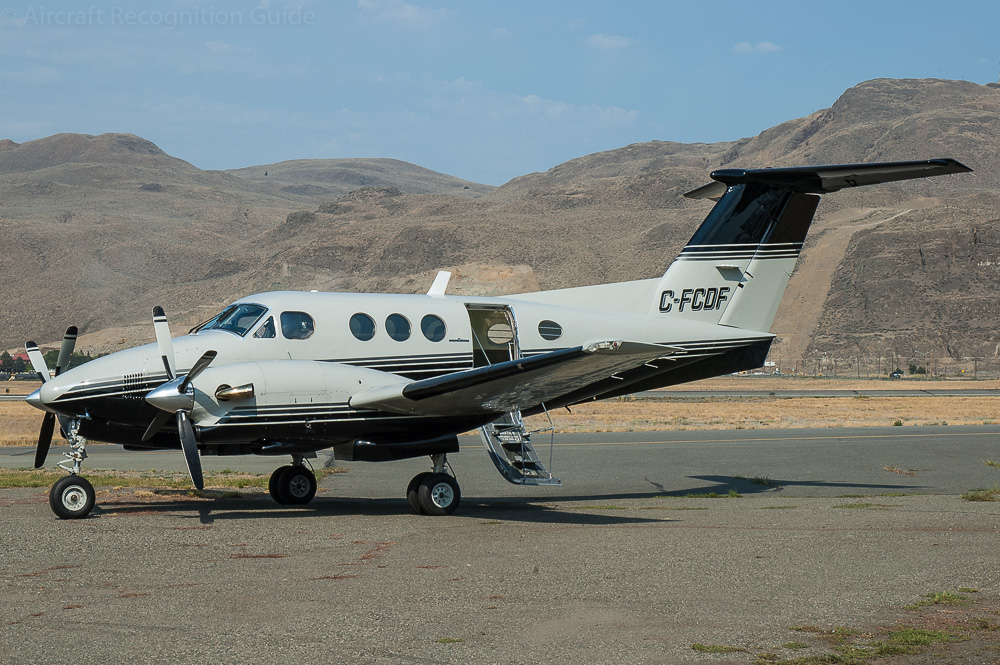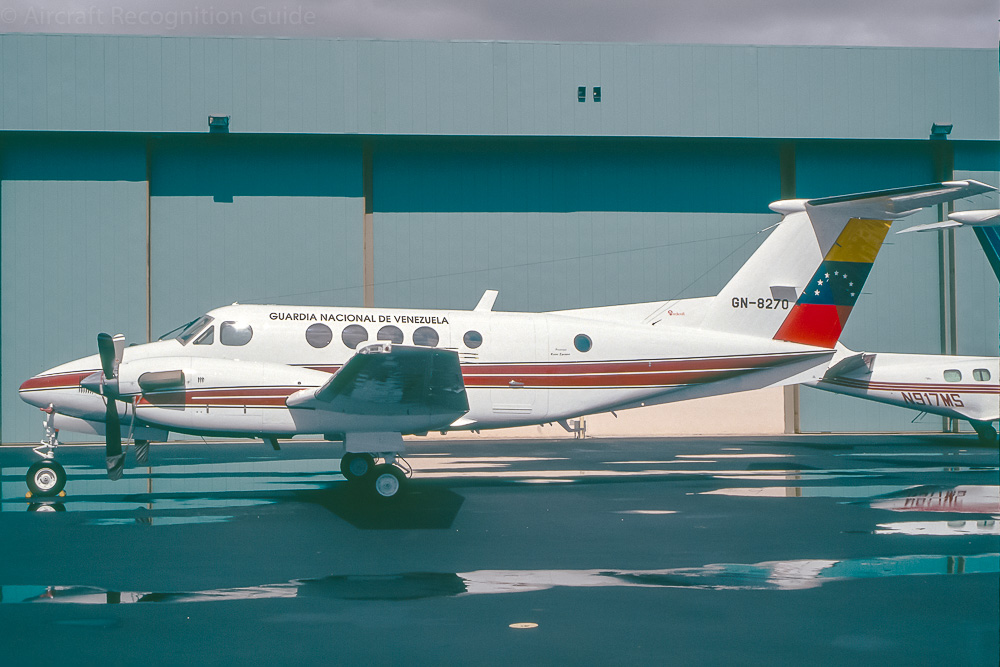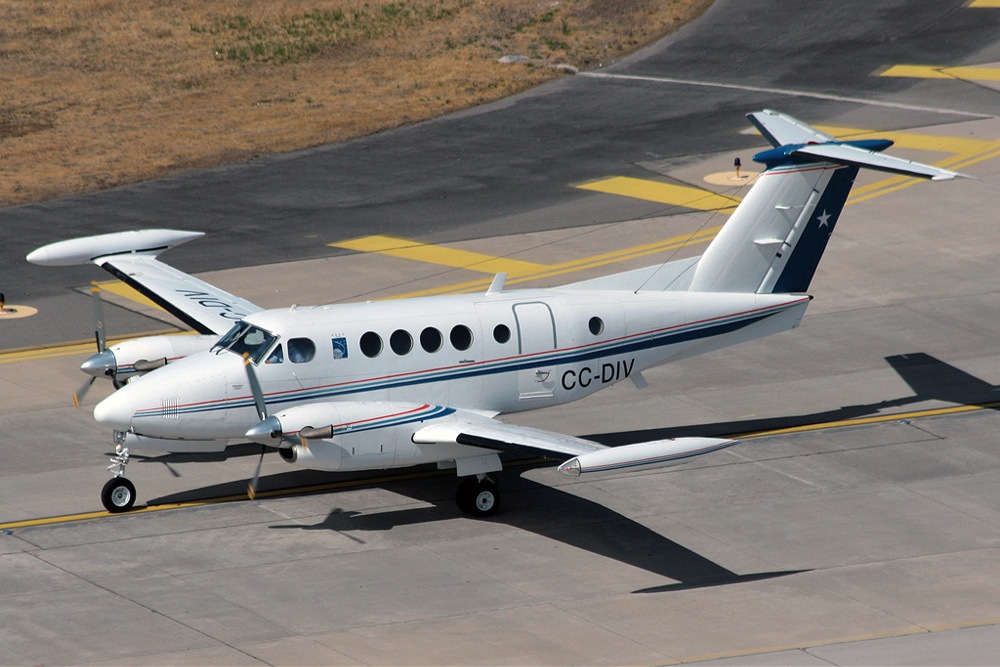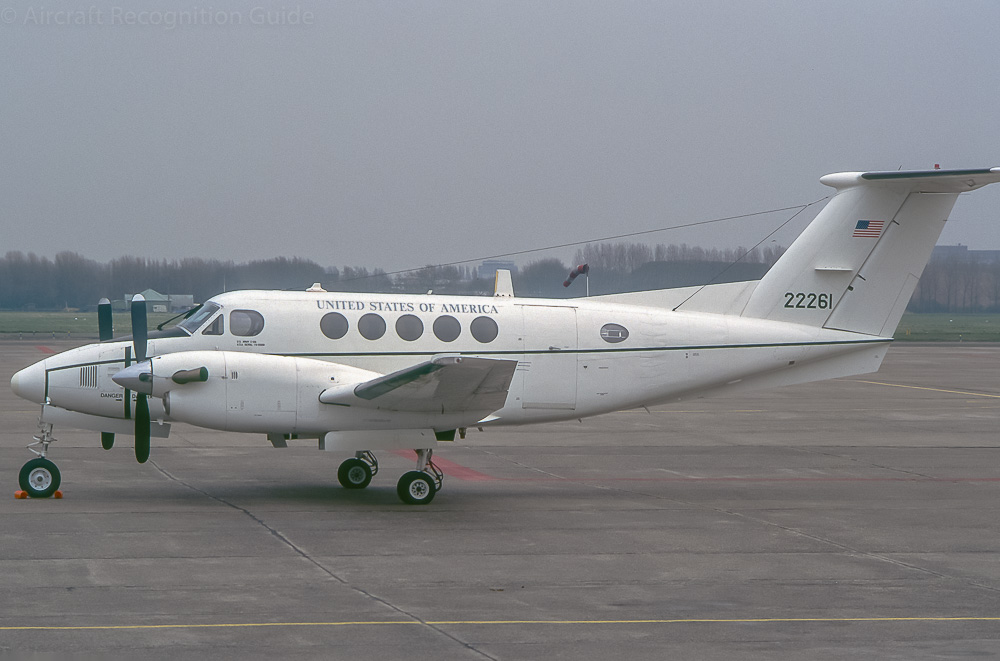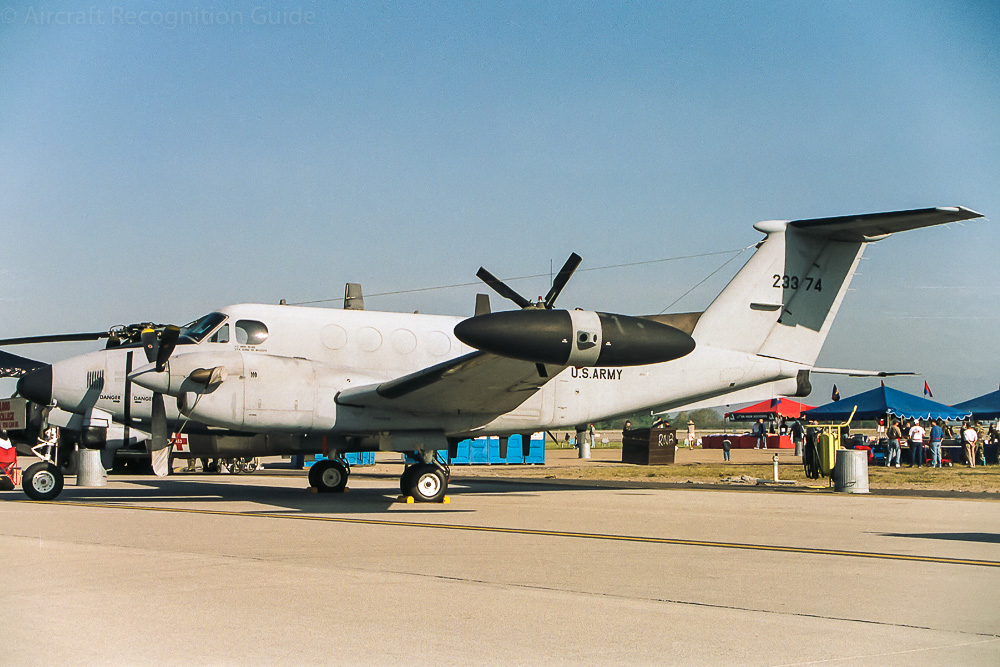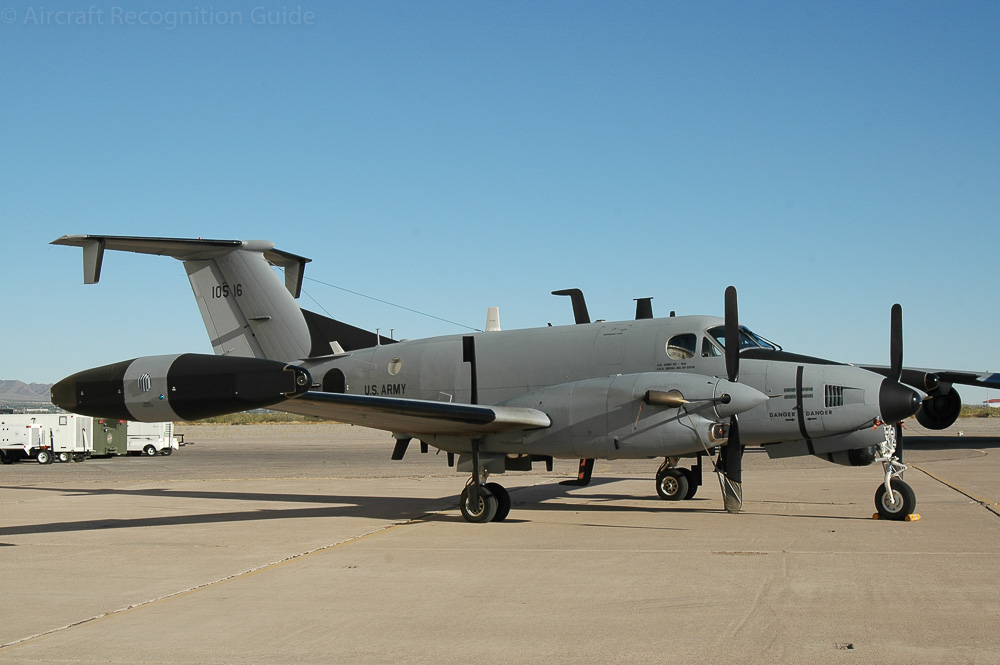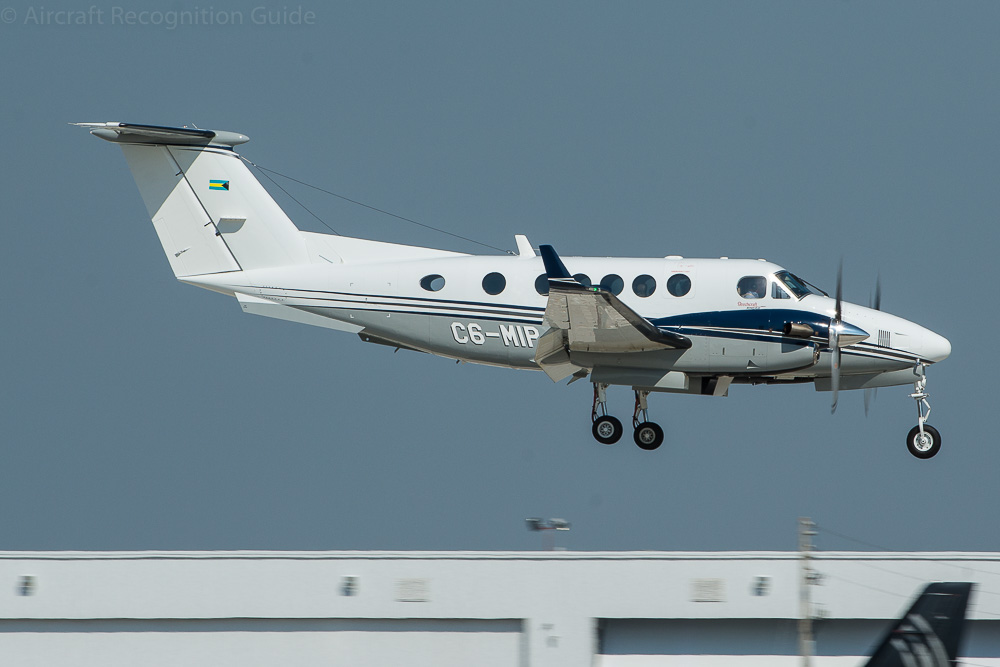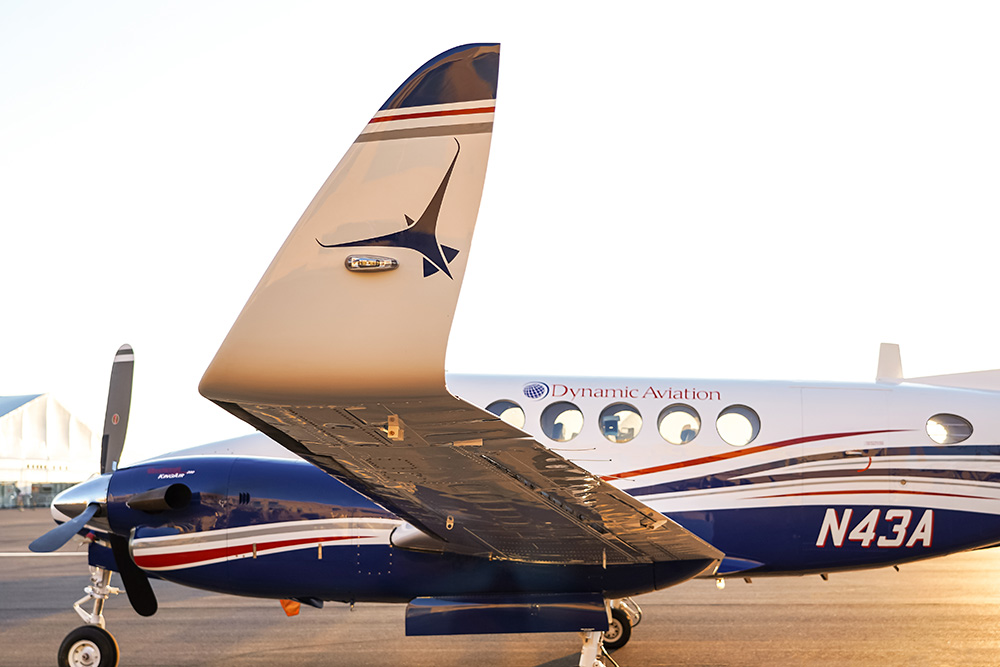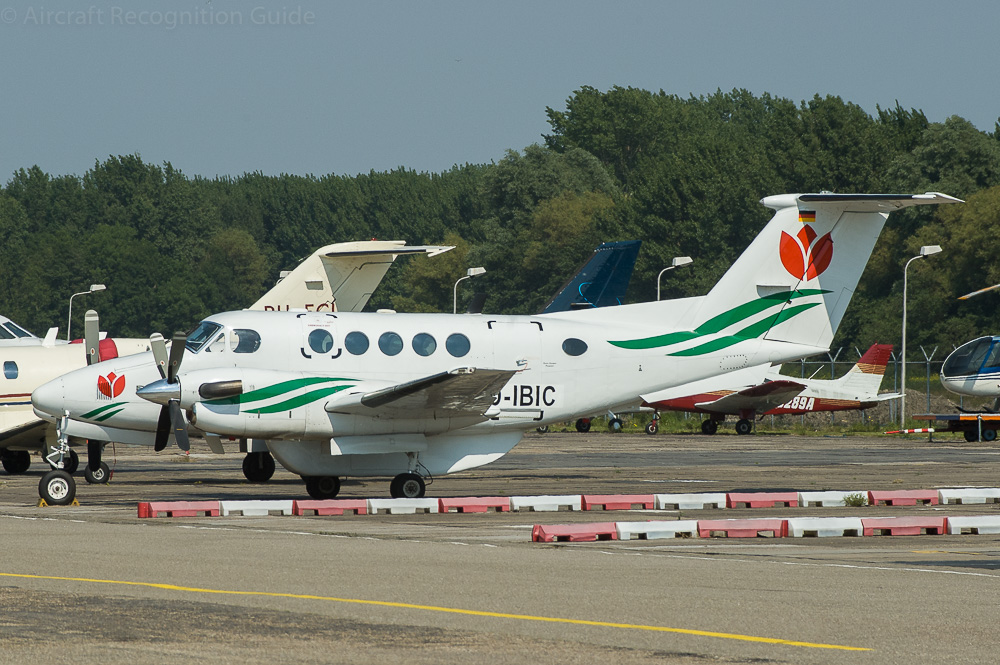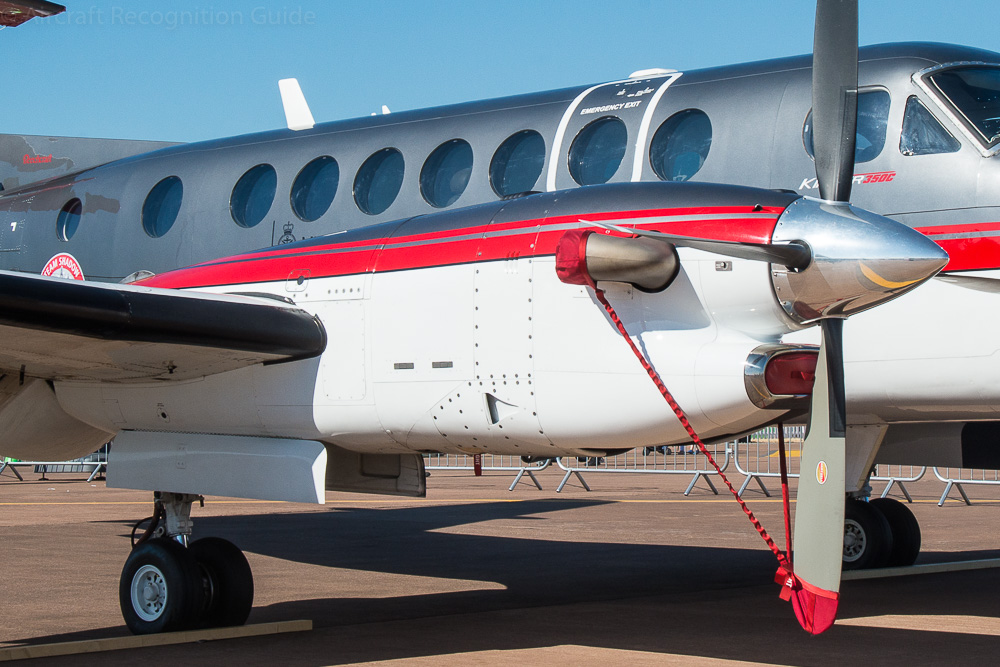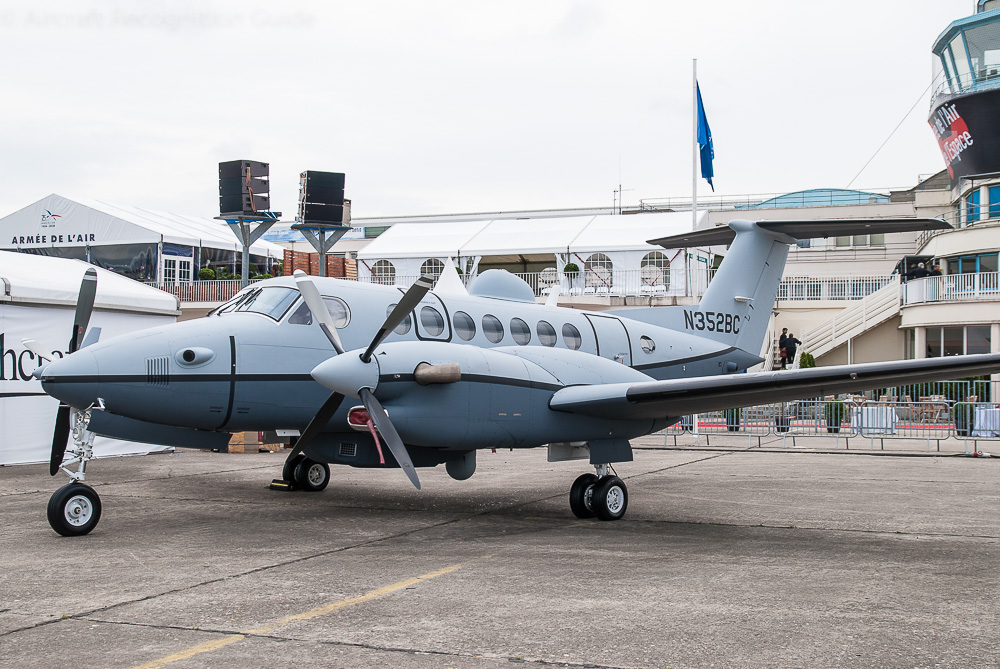
Beechcraft T-tail King Air series
After establishing the King Air as a successful twin prop series, also versions with a T-tail were developed, starting with the Super King Air and later King Air F90. Like the original King Airs (described separately) they have low wings with two turboprop engines in the wings and a main landing gear that retracts forward into the nacelles. Also the T-tail King Airs have the round cabin windows that are still used on the King Airs that roll off the production line today. The same applies to the characteristic cockpit windows, with the typical triangular and D-shaped side windows. So, basically the main difference is the horizontal stabiliser placed on top of the vertical stabiliser.
Different versions
These are the key features to recognise the different versions of T-tail Beech King Airs:
- the length of the fuselage
- the number of cabin windows
- the shape of the cabin windows
- the presence of a large cargo door
- the presence of winglets
- the presence of tip tanks
- the presence of tanks on top of nacelles
Beech F90 King Air
The smallest T-tail King Air is essentially a Beech E90 with the T-tail and wings of a Beech 200. Therefore it has only three round cabin windows in a row, while the King Air 200 has five. The Beech F90 also has a twin-wheel main gear, but the engine nacelles of the Beech E90.
Beech F90-1 King Air
Compared to the basic King Air F90 this version has the “pitot style” inlets for the engines, just like the Beech C90A. For the rest the F90-1 is the same as the original F90.
Beech G90 King Air
The Beech F90 prototype was equipped with Garrett TPE331 engines instead of the Pratt & Whitney Canada PT6As to create model G90. Therefore it probably has the same large exhaust as the Beech B100, but we have not found any photo of it. It was not produced in series.
Note this version is not to be confused with the Nextant G90XT, a re-manufactured King Air 90 (with a low tail).
Beech G90 King Air
Beech 200, B200 & B200SE Super King Air
Essentially the Beech 200 Super King Air is a Beech 100 with T-tail. So it has five cabin windows in row, supplemented by two standalone windows. The engine nacelles are different however: the intake is placed further forward, but not as far as on the Beech 300 and still has the "bean" shape. There is a single ventral fin under the rear fuselage.
The Beech B200 has more powerful engines, and standard four bladed props. As many older Beech 200s have been retrofitted with four-blade props, it is not distinguishable.
The Beech B200SE (Special Edition) is a Beech B200 with three blade props and pre-specified avionics, which makes it cheaper than the Beech B200.
Raisbeck Engineering offers many modifications of which some change the external appearance of the Super King Air: dual aft body strakes (two ventral fins), main gear doors fully enclosing the landing gear and baggage lockers at the back of the engine nacelles. This does not change the designation or marketing name however. While mostly known for the Beech 200s, the mods are also available on the King Air F90 and King Air 300 series.
The Swedish military designation for the Beech 200 is Tp103.
Here is a Beech B200 Super King Air in its original configuration, with a single ventral fin under the tail cone and short main landing gear doors. Note five cabin windows in a row.
These are the nacelles of the King Air 200 series, with a slightly recessed bean shaped air intake and no additional inlet underneath the nacelle like on the King Air F90 and 100.
This Super King Air has been modified by Raisbeck Engineering with dual aft body strakes (ventral fins) and fully enclosing main landing gear doors (longer than original).
Beech 200C & B200C Super King Air
This is a Beech 200 or B200 with a large cargo door on the left hand side. To accommodate the large door, the fifth cabin window on this side is smaller than the first four.
The USAF has used many of these aircraft as C-12F, while the US Navy designated their aircraft as UC-12F and UC-12M. Some were converted to RC-12F. With upgraded cockpit instruments and avionics the C-12F became C-12T and later C-12U.
In the 1990s the US Army also ordered this King Air model, with EFIS cockpit. These are known as C-12R. With improved avionics they became C-12V.
C-12Y is the designation of a standardised C-12 with again improved avionics and other equipment. It concerns C-12R and C-12U conversions.
The Beech 200C has a cargo door on the left side. It is better recognised by the smaller fifth cabin window.
Beech 200T & B200T Super King Air
This is a Beech 200/B200 with provisions for tip tanks to extend the range. These tip tanks are removable though, so you cannot fully depend on them for recognition. Note that the tip tanks are smaller than those used on some RC-12 versions (see below).
This Beech 200T obviously has tip tanks installed. Additionally this particular aircraft has a radome and observation window as well.
Beech 200CT & B200CT Super King Air
Combine a Beech 200T and 200C and you get a Beech 200CT, so a Super King Air with tip tanks and a large cargo door. The same applies of course for the B200T and B200C, which together make the B200CT.
A few civil Super King Airs have a cargo door and tip tanks as standard, making them a Beech 200CT, like this aircraft, or Beech B200CT. (photo: Carlos P. Valle C.)
Beech A200 (C-12A, C-12C & C-12E)
The Super King Airs built for the US military are designated as C-12 Huron. Most of these Beech 200s are a variant of model A200 (except for C-12F, C-12M and C-12R, which are a Beech B200C). The first version was for the USAF (C-12A) and US Army (C-12C). C-12As converted with PT6A-42 engines are designated as C-12E.
A C-12A of the United States Air Force looks like a regular Super King Air on the outside, but has several modifications for operations in a military environment.
Beech A200C (NC-12B, TC-12B & UC-12B)
The US Navy ordered Beech 200Cs which were delivered as UC-12B. Some were converted to TC-12B for dedicated use as training aircraft. NC-12Bs are permanent test aircraft.
A UC-12B of the United States Navy. Clearly visible is the small circular cabin window after the four in a row, typical for the Beech 200C variants.
Beech A200CT (C-12D, RC-12D, UC-12D, RC-12G, RC-12K, RC-12N, RC-12P, RC-12Q & RC-12X)
These are Beech 200CTs for the US Army, so with tip tanks. They received the nickname Guardrail. RC-12Ds and RC-12Gs were converted from C-12Ds.
RC-12s are used for many electronic tasks, for which they are equipped with antennas, some more than others. Most have tip tanks (larger than on the Beech 200T) and no or fewer cabin windows. From RC-12K on the model has Beech 300 style engine nacelles (with pitot type inlets) and many bulbs and vertical antennas on wings and fuselage, as well as additional stabilising fins underneath the horizontal stabiliser. RC-12X is the standardised version of remaining RC-12 aircraft.
RC-12s of the United States Army are mostly used for electronic tasks and hence have multiple antennas. On this RC-12D the number is limited.
The RC-12N has no cabin windows anymore, but long antennas above and below the wings, a larger dorsal fin and stabilising fins under the horizontal stabiliser.
Beech King Air 200GT (Beech B200GT)
Like the King Air 90 series, the 200 series were also fitted with a glass cockpit, creating the Beech King Air 200GT. Hence you cannot recognise it without looking in the cockpit. Also not visible are the uprated engines. This version is officially designated as Beech B200GT.
This aircraft has King Air 200GT painted on the tail to help identification, but on the outside you see no difference compared to earlier versions.
Beech King Air 200CGT (B200CGT)
This is a King Air 200GT with large cargo door.
Beech King Air 250 & King Air 260 (Beech B200GT)
Small winglets are standard on these models of the Super King Air. King Air 250 and King Air 260 are just marketing names, as the official designation is still Beech B200GT. Compared to the King Air 250 the King Air 260 has an updated autothrottle, a digital pressurisation controller, a new weather radar and newly designed seats. This all means that there are no external differences, unfortunately.
Note that these small BLR winglets can be installed on older models as well, so it is not really a good recognition point. To complicate thing further, Tamarack Aerospace also offers a winglet upgrade for King Air 200 series. These are bigger than the BLR ones and have a more pointed top. Hence you should be able to identify them easily.
In Swedish military service the King Air 260 is designated Tp54.
C6-MIP is a King Air 250 thanks to its winglets. However older Super King Airs can be retrofitted with these winglets which makes them no King Air 250; they keep their old name.
The winglets offered by Tamarack Aerospace as a retrofit on older King Air 200 series are biger and more pointed than the ones from BLR. Also the wing tips are extended a bit. (photo Tamarack Aerospace)
Beech King Air 250C & King Air 260C (Beech B200CGT)
The King Air 250 with a large cargo door is marketed as King Air 250C or 260C. The official model name remains Beech B200CGT.
Beech Catpass 250
Commuter Air Technology developed a version of the Super King Air for use on scheduled passenger services. Hence the name Catpass (Commuter Air Technology PASSenger). It is mostly recognisable by the cargo pod underneath the fuselage. Compared to the Beech 1300 the cargo pod is smaller and less streamlined.
The cargo pod under the belly makes this Beech 200 a Catpass 250 conversion. This pod is less streamlined and smaller than that of the Beech 1300.
Beech 300 Super King Air
This improved version of Beech B200 has better performing engines and some other minor changes. The pitot type air intakes (like that of the King Air C90A and F90-1) are the way to recognise it. These have the shape of a race track and are closer to the propellers.
Especially for the European market the Beech 300LW is certified with an MTOW of 12,500 lbs, which results in lower air traffic control fees, being certificated in a lower weight category. LW thus stands for light weight.
King Air 300s can be retrofitted with winglets, both the small ones from BLR and the larger ones from Tamarack. Still you will be able to identify them as a Beech 300 by the five cabin windows and pitot style air intakes.
Beech King Air 350, 350i & 360 (Beech B300)
The largest King Air ever built is a stretched version of the 300 and has seven cabin windows in a row instead of five. Also small winglets are standard. It is officially designated Beech B300, but marketed as King Air 350, 350i or 360. Compared to the standard King Air 350 the 350i has a glass cockpit. The King Air 360 has an updated autothrottle, a digital pressurisation controller, a new weather radar and newly designed seats.
The bigger winglets that Tamarack Aerospace has developed for the King Air 200 series (see above) are also available for the King Air 350. These winglets are bigger than the standard winglets and have a more pointed top. Hence you should be able to identify them easily.
Beech King Air 350C & 360C (Beech B300C)
When you place a large cargo door like that of the 200C in the King Air 350 you get the King Air 350C. This model is officially known as Beech B300C. Like the Beech 200C the last cabin window on the left side, the seventh in this case, is smaller than the others in the row.
The US Navy uses this type as UC-12W.
The King Air 350C has six big circular cabin windows in a row, followed by a smaller one, while the standard 350 has seven big windows. (photo: Ronnie Robertson/WikiMedia)
The UC-12W is a King Air 350C of the US Marines. It does not have the fuel tanks on top of the nacelles like the MC-12W (photo: Alan Wilson/WikiMedia)
Beech King Air 350ER & 360ER (Beech B300)
Specifically developed for the intelligence, surveillance and reconnaissance (ISR) market, this subtype has an increased range thanks to the large extra tanks op top of the back of the engine nacelles.
The US Navy designates this version as MC-12W Liberty and the US Army as MC-12S Huron. MC-12Ws sometimes have a radome underneath and on top of the fuselage. All MC-12Ss have been extensively modified with radomes and antennas. The Canadian call these ISR configured King Air 350ERs CE-145C Vigilance. In many cases they have two large ventral fins like the Shadow R1 below, and a long nose.
Here you can better see the fuel tanks placed on top of the rear of the nacelles, changing their shape.
Beech King Air 350CER & 360CER (Beech B300C)
In this version the large cargo door and nacelle fuel tanks are combined. For Beechcraft this remains model B300C however.
Shadow R1 is the British military designation of the King Air 350CER. These aircraft have a large radome under the mid fuselage. To enhance directional stability, two big ventral fins were added to the rear fuselage.
The Royal Navy has King Air 350CERs which they designate as Shadow R1.
Beech 1300 (Beech B200)
This is a commuter version of the Beech B200 with a large belly pod to transport luggage of the thirteen passengers, marketed as Beech 1300. This version has ventral fins underneath the rear fuselage, larger than those offered by Raisbeck Engineering as a modification.
The dedicated commuter version of the Super King Air is known as Beech 1300. It has a bigger baggage belly than the Catpass 250 conversion.
Confusion possible with
Beechcraft 1900
The Beech 1900 at first looks like a strecthed Super King Air. Indeed both types share the typical King Air cockpit windows, and to a large extent also the wings, engine nacelles and tail. However, apart from the length you can recognise a Beech 1900 by the oval cabin windows and extra stabilising fins on the tail.
Embraer Xingu
The Xingu is similar in appearance to the King Air F90 as it has about the same size, has a T-tail, low wings and two turboprops in the wing. However, cockpit and cabin windows are different and the main landing gears each have a single wheel compared with two on the Beech.
Piper PA-42 Cheyenne III
Some Piper Cheyenne versions also got a T-tail, making them more similar in appearance as the T-tail King Air. However the PA‑42 is easily distinguished from the King Airs by the large rectangular cabin windows. Also the main gear retracts sideward.
Beechcraft King Airs with a low tail
Early model King Airs have low mounted horizontal stabilisers (which is in itself a clear recognition point), but are for rest essentially the same as the T-tail King Airs. Therefore if you don't see the tail you can easily mix them up.





